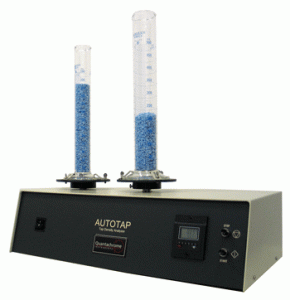 Autotap and Dual Autotap
Autotap and Dual Autotap
The tapped density of powdered, granular of flakey material is highly dependent on the manner in which the particles are packed together. During tapping, particles gradually pack more efficiently, the powder volume decreases and the tapped density increases.
The Autotap automates the lifting and dropping of the powder container (usually a glass graduated measuring cylinder) thereby eliminating both the expected variability and possible wrist injury when done by hand, not least because most materials require hundreds if not thousands of taps before reaching maximum tapped density. If you need to ensure the same fixed number of taps for all analyses, a special lockout feature is provided which prevents unauthorized changes to the counter.
Available Options
The Autotaps are normally supplied with 250ml cylinders, but you may request 10ml, 25ml, 50ml, 100ml or 50ml instead. A larger optional platform is required to accommodate the largest cylinder we offer, the 1000ml. But, of course, this platform does accommodate all the smaller cylinders too.
Tap (Tapped) Density
Both Autotaps conform to a number of international standards for tap density, namely ASTM B527, D4164 and D4781, plus British Pharmacopoeia method for Apparent Volume, USP <616> method II, and ISO 787-11. The unique platforms accommodate different size cylinders for different standards and for differing amounts of available sample. Most samples are analyzed “as-is”, normally there is no special preparation needed, just pour the powder into a suitably sized cylinder. Securing (and releasing) the cylinder(s) on the platform(s) is both easy and rapid. Then just dial in the desired number of taps and press “start”. Tapping ceases automatically after the prescribed number of taps.
Hausner Ratio & Carr’s Compressibility Index
By comparing the initial (loose) powder volume with the final (tapped) volume one can predict the flowability of a powder. This comparison is normally done by calculating the ratio of the volumes (Hausner) or the change in volume as a percentage of the initial volume (Carr’s).
Geometric (envelope) density
Sometimes called particle density or apparent density, the geometric density reflects the volume of particles including internal pores and small surface irregularities. Important, therefore, for a host of manufactured and natural porous materials it is simply and inexpensively measured using a dry powder pycnometer attachment for the Autotap and either a coarse or fine pycnometric powder, according to the scale of pore size and surface features under test.
Specifications
- Available as 110-220V/60Hz or 220-240V/50Hz
- Tap height: 3mm(1/8″).
Optional 1mm drop also available. - Tapping rate: 260 per minute
- Tap counter: 1- 999999 with auto-stop
- Continuous tapping: yes, if so desired (manual stop)
- Platform rotation: automatic
- Controls: on/off, start, stop, counter reset.
- Load limit: 900g (2lb) with no effect on tapping rate.
